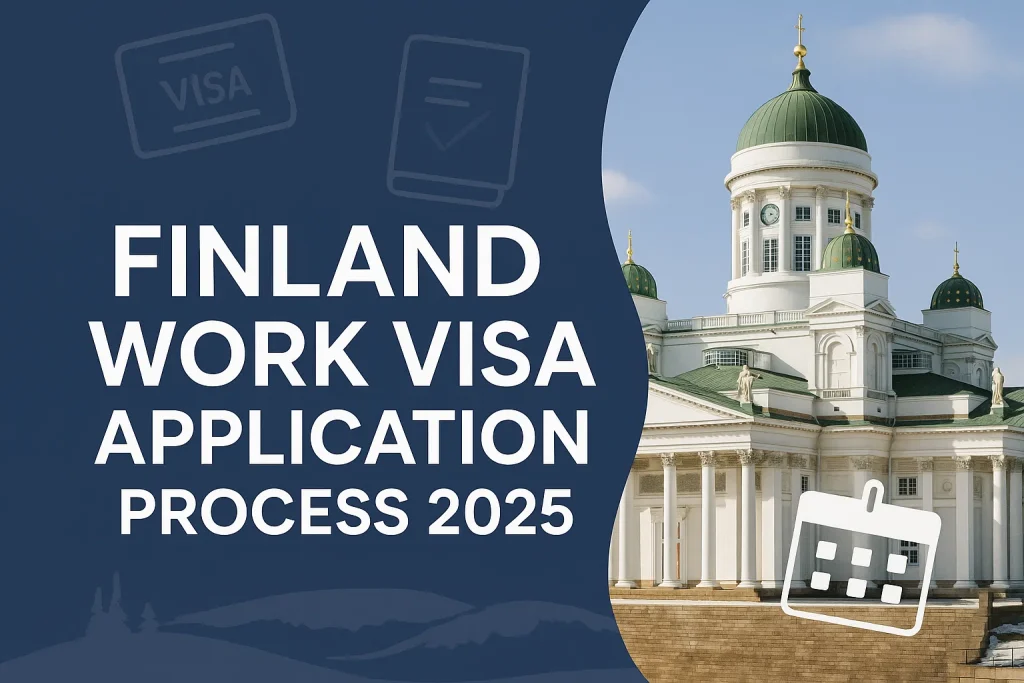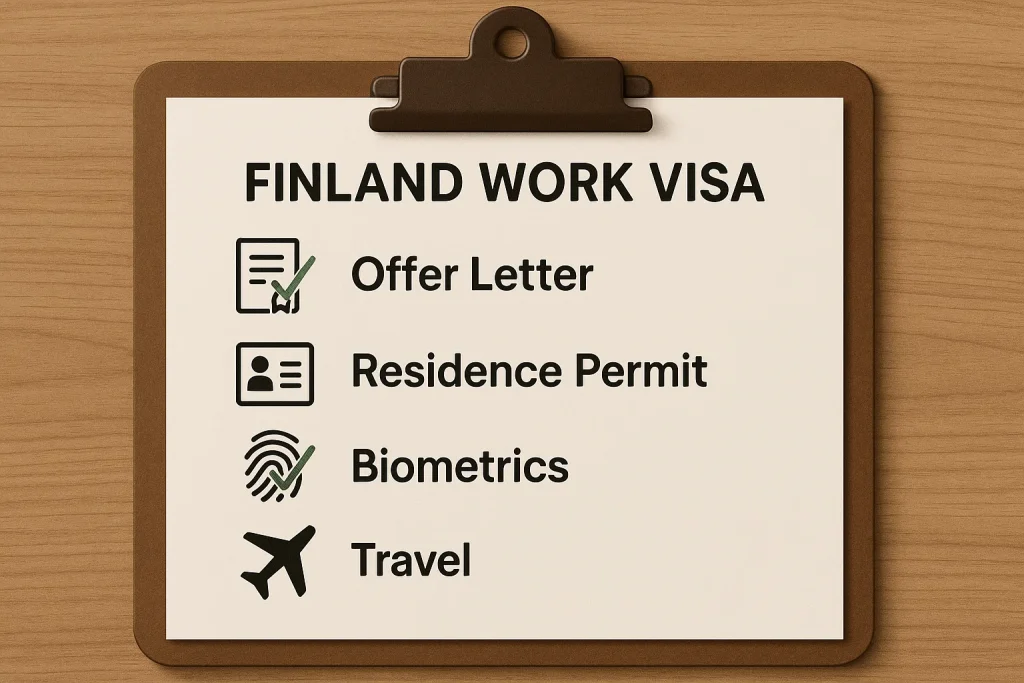Thinking about working abroad in 2025? If Finland is on your radar, you’re not alone.
With its thriving tech industry, high quality of life, and a growing demand for skilled international workers, Finland has become one of the top destinations for global talent. But before you can pack your bags and start your Nordic adventure, there’s one crucial step you’ll need to master—the Finland work visa application process.
Whether you’re a recent graduate eyeing job opportunities in Helsinki or a seasoned professional seeking a fresh start in Europe, understanding how to navigate Finland’s visa system is the first big milestone on your journey.
As experienced educational content creators who’ve guided countless readers through complex immigration and study abroad procedures, we’ve seen how overwhelming it can be to sift through official documents, visa types, eligibility requirements, and deadlines. That’s why we’ve created this comprehensive, beginner-friendly guide.
In this article, we’ll break down everything you need to know about applying for a work visa in Finland in 2025. From the types of work permits available to step-by-step instructions and common mistakes to avoid, we’ve got you covered.
This isn’t just a list of requirements—it’s a roadmap, packed with real-life tips, expert insights, and helpful comparisons that will make your application process smoother, faster, and far less stressful.
Ready to dive in? Let’s get started with the different types of Finland work visas available in 2025.

Types of Finland Work Visas Available in 2025
Finland offers several types of work visas, each tailored to different job roles and career paths. Choosing the right one depends on your profession, job offer, and the nature of your work. Below, we’ve outlined the most common options.
Residence Permit for Employment
This is the most widely used work visa in Finland. It’s designed for people who have a confirmed job offer from a Finnish employer. It applies to full-time, long-term employment in almost any field.
Specialist Permit for Highly Skilled Workers
This visa is ideal for professionals in roles that require special skills or higher education—such as IT experts, engineers, and researchers. It’s one of the fastest to process, especially when submitted through the Fast Track service by the Finnish Immigration Service (Migri).
Seasonal Work Visa
If you plan to work in agriculture, forestry, or tourism for a short time, this is the right visa for you. It’s valid for up to 9 months and suits temporary or part-time roles.
EU Blue Card for Finland
The EU Blue Card is for highly qualified non-EU nationals. It requires a higher-than-average salary and a recognized university degree. It offers a smoother path to permanent residence in Finland and the wider EU.
[Insert Table: Add summary data comparing types of Finland work visas – validity, eligibility, processing time]
| Visa Type | Who It’s For | Validity Period | Processing Time | Requires Job Offer |
| Residence Permit for Employment | General employment roles | 1–2 years | 1–3 months | Yes |
| Specialist Permit | Highly skilled professionals | 1–2 years | ~2 weeks (Fast Track) | Yes |
| Seasonal Work Visa | Temporary workers (agriculture, tourism) | Up to 9 months | ~1 month | Yes |
| EU Blue Card | Highly qualified non-EU professionals | Up to 2 years | 1–2 months | Yes |
Who Can Apply for a Finland Work Visa?
Before applying, it’s important to know whether you meet the basic requirements. Let’s break this down.
Eligibility Criteria in 2025
To apply for a work visa in Finland, you must meet the following:
- Be a non-EU/EEA citizen
- Have a valid job offer from a Finnish employer
- Meet the minimum salary threshold (varies by visa type)
- Hold necessary qualifications or experience for the job
- Have no criminal background that would prevent entry
If you’re already in Finland under a different visa (like a student visa), you may be eligible to change your status to a work permit if you meet the criteria.
Job Offer Requirements
Your job offer plays a key role in the application. It must be:
- Official and signed by the employer
- Full-time or at least meet the hours for eligibility
- Within a field that requires your skill set
The employer may also need to prove that the job cannot easily be filled by someone already residing in Finland or the EU. This is called the labour market test.
Educational and Professional Qualifications
While not all work visas require a university degree, your background must match the position. For instance:
- A software engineer may need a degree in computer science
- A seasonal farm worker might only need prior experience
- A specialist permit applicant must usually show a formal education and relevant job experience
Always check the Migri site for the latest qualification rules by profession.
Step-by-Step Guide to the Finland Work Visa Application Process

Applying for a Finland work visa in 2025 may seem complex, but when broken down, it’s manageable. Here’s how to go through it step by step.
Step 1 – Secure a Job Offer from a Finnish Employer
You can’t apply for a Finland work visa without a job offer. Start by browsing job sites like:
- Job Market Finland (TE Services)
- Work in Finland
- EURES – The European Job Mobility Portal
Once you receive an offer, make sure it includes all the details: salary, job title, duties, and duration.
Step 2 – Prepare the Required Documents
Gather these items before you apply:
- Valid passport
- Passport-size photo
- Signed employment contract
- Proof of qualifications (diplomas, certificates)
- CV or resume
- Any licensing documents (for regulated jobs)
- Criminal record certificate (if required)
Be sure to check the specific list for your visa type at Migri’s application info page.
Step 3 – Submit Your Application on Migri.fi
Head to Enter Finland and create an account. Fill out the online form and upload your documents. You’ll also need to choose your visa type and provide your job details.
Step 4 – Pay the Application Fee
The fee varies depending on the visa type and whether you apply online or in person. For example:
- Online: €490
- Paper application: €690
Check the exact fees on Migri’s service pricing page.
Step 5 – Attend the Interview or Biometrics Appointment
After submitting your application, you’ll be asked to visit a Finnish embassy or consulate (or local service point in Finland) to verify your identity and provide biometrics. Some applicants may also be interviewed.
Step 6 – Wait for a Decision from Migri
Processing times can vary by visa type. Specialist permits through Fast Track can be approved in about two weeks, while general employment visas may take 1–3 months. You can track your application’s progress via Enter Finland.
Documents Required for the Application
Having the right documents ready is key to getting your Finland work visa approved without delays. We always recommend double-checking the specific requirements listed on the Finnish Immigration Service (Migri) website, but here’s a general list to help you get started.
Basic Document Checklist for 2025
Before applying, gather all the documents listed below. Submitting a complete and accurate file is one of the easiest ways to fast-track your application.
- Valid passport – Make sure it’s not expiring soon.
- Passport-size photo – Must follow official photo guidelines.
- Signed employment contract – Provided by your Finnish employer.
- Proof of qualifications – Diplomas, certificates, or training records.
- Updated CV/resume – Use Europass format if applying for jobs across the EU.
- Criminal record certificate – Required for many visa types. Must be recent and possibly translated.
- Medical insurance (if required) – Especially for seasonal or short-term workers.
- Proof of accommodation (optional) – Can strengthen your case.
- Receipt of paid application fee – Always keep a copy.
If any documents are not in Finnish, Swedish, or English, they must be translated by an official translator. Migri may also ask for more papers depending on the job or visa type.
Tips for Organizing Your Documents
We always suggest keeping both digital and printed copies. Organize them in folders labeled clearly, so you’re ready if asked to resend or show them at a visa interview.
Using a checklist app or Enter Finland’s document tool can help you keep track of what you’ve uploaded.
Finland Work Visa Processing Time in 2025
Knowing how long your application might take can help you plan your move, quit your job, or book your travel. Processing time depends on your visa type, the season, and whether you’re using Finland’s Fast Track system.
Estimated Processing Times by Visa Type
We’ve created a simple table to help you understand what to expect in 2025.
| Visa Type | Average Processing Time (Online) | Fast Track Option Available? | Notes |
| Residence Permit for Employment | 1–3 months | No | Times may vary by workload |
| Specialist Permit | 2–3 weeks | Yes | Often approved within 14 days |
| Seasonal Work Visa | 1 month | No | Shorter duration means faster review |
| EU Blue Card | 1–2 months | No | Requires proof of high salary/degree |
You can track your application’s real-time status at Enter Finland. If anything is missing or incorrect, Migri may contact you, which can slow things down.
Factors That Can Delay Processing
Even small mistakes can cause delays. These include:
- Missing documents
- Incorrect application fee
- Poor-quality photo
- Job offer not clearly stated
- Translations not certified
Avoid delays by reviewing Migri’s application checklist before submitting your paperwork.
Common Mistakes to Avoid During the Application Process
Even with a strong job offer and great qualifications, simple mistakes can hold you back. Based on our experience helping people with international visa applications, here are the most common missteps we’ve seen—and how to avoid them.
Mistake #1 – Not Applying Through the Right Visa Channel
Each visa has its own set of rules. Applying for a general work permit when you qualify for a specialist one (or vice versa) can lead to a rejection. Always review visa types on Migri’s site before starting your application.
Mistake #2 – Leaving Out Required Documents
Missing even one document can result in delays or denial. Double-check every item before submitting. Create a folder labeled “Work Visa 2025” on your desktop and keep everything there. This way, you can update or reupload documents fast.
Mistake #3 – Incomplete or Vague Job Offer
Your job offer must clearly state:
- Your title and responsibilities
- Contract duration
- Full-time or part-time status
- Salary details
Migri may contact the employer if anything looks unclear, which can delay things.
Mistake #4 – Ignoring Translation Rules
Any document not in Finnish, Swedish, or English needs to be translated by a certified translator in your country or Finland. Unofficial translations are often rejected.
Mistake #5 – Skipping the Labour Market Test (When Required)
Some jobs need your employer to do a labour market test. This proves they couldn’t find a local worker for the job. If your role requires it and your employer skips it, your visa may be denied. You can read more on labour market testing on Migri’s site.
How Much Does a Finland Work Visa Cost?
Understanding the full cost of getting a work visa is just as important as preparing your documents. It helps you plan ahead and avoid surprise fees. Finland’s visa fees vary depending on the type of permit, whether you apply online or on paper, and if you use the Fast Track option.
Work Visa Fee Breakdown in 2025
Here’s a simple table to guide you through the main visa categories and their costs:
| Visa Type | Online Application Fee | Paper Application Fee | Fast Track Available? |
| Residence Permit for Employment | €490 | €740 | No |
| Specialist Permit | €540 | €740 | Yes |
| Seasonal Work Visa | €95 | €195 | No |
| EU Blue Card | €540 | €740 | No |
All official fees are listed on the Migri fee page, which is updated regularly. Keep your receipt safe, as you may need to show it later.
Other Costs to Consider
In addition to visa fees, you might also spend money on:
- Document translations by certified translators
- Travel to the embassy or service point
- Legalization or apostille of documents
- Courier services for sending paperwork
These add-ons can push the total cost up, so we always suggest budgeting an extra €100–€200 on top of the visa fee.
Living and Working in Finland: What to Expect
Getting a work visa is just the beginning. To truly make the most of your time in Finland, it’s good to know what everyday life is like there. Based on our experience helping students and professionals relocate, here’s what you can expect.
Work Culture in Finland
Finland is known for its honest and low-hierarchy workplaces. People value direct communication, punctuality, and a healthy work-life balance. It’s not uncommon for teams to have open discussions where everyone’s input is welcomed.
- Typical workweek: 37.5 to 40 hours
- Paid vacation: At least 4 weeks per year
- Sick leave: Generous, with employer support
- Maternity and paternity leave: Among the best in the world
You can explore Finland’s employment laws through InfoFinland.
Cost of Living in Major Cities
Living costs in Finland are reasonable compared to other European countries. Helsinki is the most expensive, while cities like Tampere or Oulu offer more affordable options.
Here are some average monthly expenses:
- Rent for one-bedroom apartment: €700–€1,200
- Groceries for one person: €250–€350
- Public transport pass: Around €60
- Internet and mobile plan: €30–€40
The Numbeo cost of living tool is a great way to check up-to-date estimates for different cities.
Language and Integration
Many people in Finland speak excellent English, especially in workplaces. However, learning basic Finnish or Swedish (the second official language) can help with social integration and job prospects.
The government offers free language courses through integration programs for new residents.
Benefits of Getting a Finland Work Visa in 2025

So, why should someone choose Finland over other countries? From job opportunities to quality of life, the reasons are strong. Based on years of helping people move abroad, here are some top benefits I always highlight.
Strong Job Market and Talent Demand
Finland is actively looking for skilled workers in IT, engineering, healthcare, and education. The country is dealing with a labor shortage, especially in tech and elderly care. That’s why getting a job here may be faster than in other EU countries.
The Ministry of Economic Affairs and Employment updates a list of high-demand sectors every year. If your skills match, your chances improve a lot.
Pathway to Permanent Residency and Citizenship
A Finland work visa can open the door to long-term opportunities. After living in Finland for four years with a continuous permit, you may apply for permanent residency. After that, you could even apply for Finnish citizenship if you meet the language and stay requirements.
This step-by-step path is a big draw for people looking for a stable future in Europe.
High Quality of Life and Safety
Finland is regularly ranked as the happiest country in the world, according to the World Happiness Report. It’s also known for low crime rates, great healthcare, and clean air. Families, in particular, appreciate the free education system, safe cities, and support for parents.
Workers also benefit from excellent employee rights, flexible working hours, and strong social security. All of these make day-to-day life easier and more fulfilling.
Travel Access Within the EU
With a valid Finland residence permit, you can travel across the Schengen Area without a visa for up to 90 days in a 180-day period. This is perfect for weekend trips or business travel. Countries like France, Germany, and Italy are just a short flight away.
Learn more about Schengen travel rules on the European Commission website.
Final Thoughts
If you’re planning to work in Europe, Finland is one of the best places to start. The country offers a clear visa process, a strong job market, and a high standard of living. In 2025, it’s easier than ever to apply online, track your case, and even fast-track your permit in some cases.
Whether you’re in tech, healthcare, education, or seasonal work, there’s a growing demand for global talent. With the right documents and guidance, you can build a rewarding career — and life — in Finland.
Want help getting started? Bookmark this guide, check out Migri.fi, and start planning your move today.


